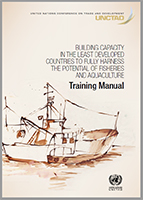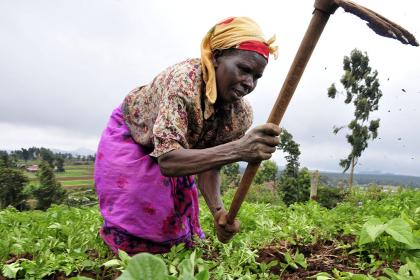
UNCTAD has been implementing a Development Account Project designed to build the export capacities of LDCs and other vulnerable economies to enhance the role of the fisheries and aquaculture sector.
The outputs of the project include the establishment of Regional Centres of Excellence in Asia and Africa for training experts, policy practitioners and policymakers, for conducting research and policy analysis, preparation of training manuals to upgrade and diversify fishery exports and support implementation of training modules.
This manual was prepared to serve as a principal reference for UNCTAD’s training and technical assistance programmes.
Objectives:
- To make available a coherent, consolidated and updated document to train experts, policy practitioners and policy makers on how to best maximize socioeconomic and environmental benefits of the fisheries and aquaculture sector.
- To serve as a key document to assist LDCS and other vulnerable economies to develop their fisheries and aquaculture sector by learning from the experiences of successful developing countries.
- To facilitate sharing of successful experiences and best practices by enhancing South-South Cooperation and reinforcing the Regional Centres of Excellence.
- To provide holistic training and capacity building support in harnessing the potential of the fisheries and aquaculture sector.
Equally important, this manual can also help to identify policies and strategies for enhancing the role of the fisheries and aquaculture sector in achieving SDGs in structurally weak and vulnerable economies in Asia and Africa including by enhancing their capacities to develop and diversify their fish exports.
This is particularly important in view of the stringent requirements of importing countries which continue to undermine exports of fish and fish products, which, in turn, limit the export baskets of several developing countries to a few primary commodities.
The manual is organized into five chapters that address respectively:
- The multidimensional potential of fisheries and aquaculture to contribute to food security, socio economic development and environmental protection.
- The fundamentals and practical aspects of fisheries management to restore the productive capacity of oceans and sustainable fisheries.
- The potential and requirements for aquaculture to sustain food and nutrition security, economic growth and environmental protection.
- Best practices for value addition along the fish and seafood value chain.
- Standards and certification in international fish trade.
The manual is destined for fisheries and aquaculture policy practitioners and policy makers. Care has been exercised to demystify the concepts and present key information aligned with internationally recognized instruments and codes of best practices.
A bibliography has been compiled to access further information of interest to academicians, researchers and technical experts.




